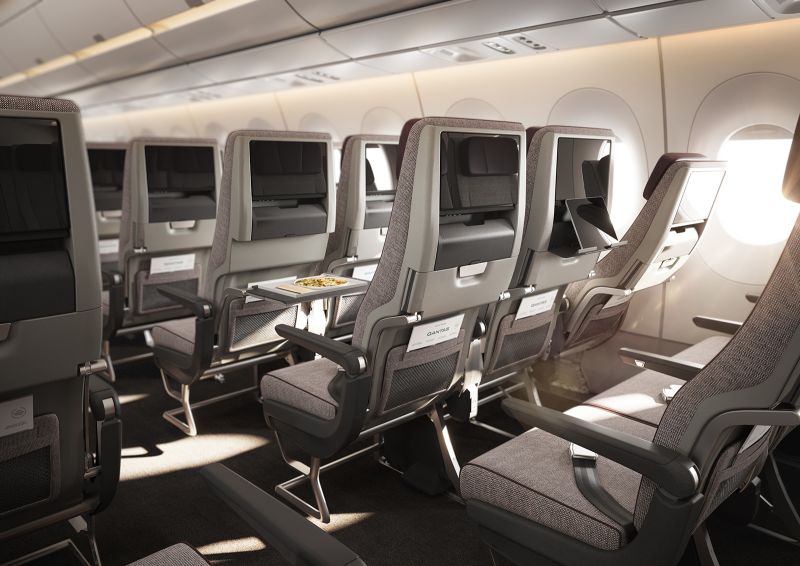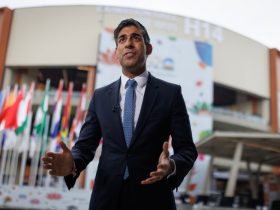As Qantas counts down to the 2025 launch of its record-breaking passenger flights connecting Sydney to New York and London direct, the airline has revealed what economy class will look like on the ultra long-haul flights.
Speculation has been mounting about the design of the cheaper seats, with many observers questioning whether spending at least 19 hours in such close proximity to other fliers would be worth the time saved by traveling nonstop.
At a press conference in New York on Thursday, the airline revealed it will offer passengers more leg room and more space to move around the cabin on the 12 specially designed Airbus A350 planes that will operate the routes.
“We said what we wanted to do with this, that it was to overcome the last tyranny of distance: to have an aircraft that could fly anywhere around the world,” Qantas CEO Alan Joyce told reporters.
Getting an aircraft capable of flying up to 21 hours with a full manifest of passengers plus baggage was part of the jigsaw puzzle, Joyce said. Another focus has been to find the best way to look after people on such a long flight.
Free WiFi
The airline already revealed its business and first class cabins back in February. At the same time it announced its Project Sunrise flights would carry 238 passengers instead of the usual 300-plus when they take to the air in late 2025.
It said the layout would include six first class seats in a 1-1-1 configuration, 52 business class seats in 1-2-1, 40 premium economy seats in 2-4-2 and 140 economy seats in 3-3-3.
Those economy seats will be an inch longer than standard, the airline revealed on Thursday, giving passengers 33-inches of legroom.
Each seat will also have Bluetooth connectivity and free Wi-Fi, which will help with binge-watching TV series on the flight, said Joyce, who revealed he gorged on “The White Lotus” on his way over to the US from Australia.
The economy cabin will also have “wellness zones” with TV screens guiding travelers through stretching exercises and bars to help them balance.
Passengers will also be kept awake for much longer at the start of the flight than they currently are thanks to “energizing food,” lighting and temperature.
“We think this is a unique value proposition as an airline that we’ll be able to offer … showing people how to have a very healthy trip, to look after the wellness, and to avoid jet lag, and to come into a destination refreshed,” said Joyce.
Shortening jet lag
The airline has been working with sleep researchers from the University of Sydney’s Charles Perkins Centre. The team studied passengers on three ultra long-haul test flights Qantas conducted in 2019 and found that food and conditions could reduce jet lag.
“First, we found that the duration of self-reported jetlag is shortened by about two days in the optimized groups compared to the traditional ones,” said Svetlana Postnova, neurophysics and brain dynamics specialist at the University of Sydney.
“Second, we found that alertness in the days immediately following the flight is higher in the optimized group than the traditional one.”
As well as studying passengers on test flights, Qantas has also been using data from the flight crew to make the case to Australian aviation regulators that the nonstop routes can be flown safely.
Joyce said the reduction in seat numbers was a crucial part of the equation.
“This aircraft has a lot less seats, more premium seats, and a lot more space for customers because we believe that’s the level of comfort that’s needed when you’re doing ultra long-haul travel,” said Joyce.
At the front of the planes, first class passengers will enjoy an extra-wide bed, a 22-inch wide recliner lounge chair, a full-length wardrobe, a folding dining table – large enough for two – and a 32-inch ultra-high-definition TV.
Joyce jokingly said first class pods were equipped with “…everything except the dunny (Australian slang for toilet) on board.”
Into the record books
Business class suites will be 42 inches wide with 25-inch-wide chairs that can be reclined into a two-meter bed. They will also include a cushioned leather ottoman, a large mirror, plenty of storage space and an 18-inch ultra-high-definition touchscreen.
The Project Sunrise flights take their name from high-risk clandestine flights during World War II that saw two sunrises as they made their way from Perth to Sri Lanka en route to London.
During Qantas research flights in 2019, pilots wore brainwave monitors and had urine tested in the weeks before and after the flights to track levels of melatonin, a hormone linked to sleep cycles.
Passengers in the main cabin wore monitoring devices, allowing scientists to study how their “health, well-being and body clock” were impacted by variables including lighting, food and drink, movement, sleep patterns and inflight entertainment.
The current world’s longest scheduled passenger flight currently in service, that honor goes to Singapore Airlines’ Singapore-JFK flight, which covers 9,536.5 miles.
Flights from Singapore to JFK take 18 hours and 5 minutes, while JFK to Singapore takes 18 hours and 40 minutes, due to the headwind.






